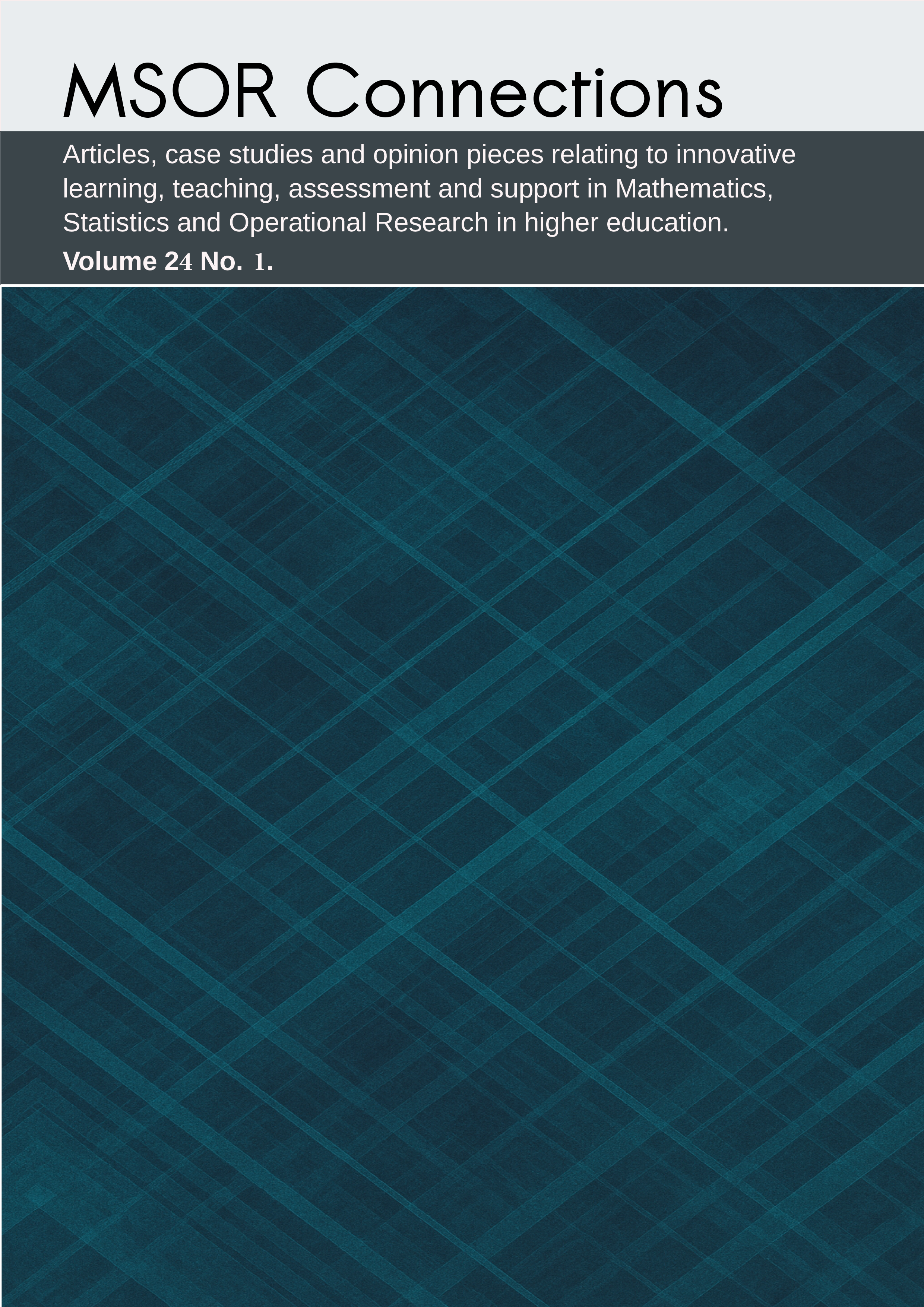Student Perceptions of TabletPC Use in Mathematics Teaching, and Student Preferences of Different Delivery Modes
Keywords:
Mathematics Education, Lecture Delivery, TabletPC, Education TechnologyAbstract
Traditional mathematics education using a blackboard has, in recent decades, been complemented or replaced by emerging technologies. The pandemic was a notable catalyst for adoption of technology, as educators had no choice but to engage with technology so that learning and teaching could continue remotely. The present research was conducted at a large UK university which invested in TabletPCs to facilitate this remote education. The research verified that the benefits of TabletPCs described in the literature were indeed being achieved locally. The research further explored student perceptions and preferences of different lecture delivery modes, including TabletPCs and boards. The research was conducted before and after remote delivery to explore whether student opinions differed following this period of greater exposure to technology-driven education. The main result of the research is a student preference for multi-modal lecture delivery, which was slightly stronger in the post-pandemic survey. A further recommendation is for educators to consider the value of different tools and their individual advantages when planning teaching activities, rather than being led by a strong discipline culture.
References
Billman, A., Harding, A. & Engelbrecht, J. 2018. Does the chalkboard still hold its own against modern technology in teaching mathematics? A case study. International Journal of Mathematical Education in Science and Technology, 49, 809-823, http://doi.org/10.1080/0020739X.2018.1431852.
Boyle, J. R., Forchelli, G. A. & Cariss, K. 2015. Note-taking interventions to assist students with disabilities in content area classes. Preventing School Failure: Alternative Education for Children and Youth, 59, 186-195, http://doi.org/10.1080/10459881003785506.
Chandler, P. & Sweller, J. 1992. THE SPLIT-ATTENTION EFFECT AS A FACTOR IN THE DESIGN OF INSTRUCTION. British Journal of Educational Psychology, 62, 233-246, http://doi.org/10.1111/j.2044-8279.1992.tb01017.x.
Day, R. S. The original teaching machine—The blackboard. The Educational Forum, 1967. Taylor & Francis, 195-201, http://doi.org/10.1080/00131726709338041.
Ellis-Behnke, R., Gilliland, J., Schneider, G. & Singer, D. 2003. Educational benefits of a paperless classroom utilizing tablet PCs. Massachusetts Institute of Technology, Cambridge, Massachusetts-USA,
Emerson, P. 1896. OCEAN CIRCULATION.—(II). The Journal of Education, 43, 330-331
Fister, K. R. & Mccarthy, M. L. 2008. Mathematics Instruction and the Tablet PC. International Journal of Mathematical Education in Science and Technology, 39, 285-292, http://doi.org/10.1080/00207390701690303.
Galligan, L., Hobohm, C. & Loch, B. 2012. Tablet technology to facilitate improved interaction and communication with students studying mathematics at a distance. Journal of Computers in Mathematics and Science Teaching, 31, 363-385
Gorgievski, N., Stroud, R., Truxaw, M. & Defranco, T. 2005. Tablet PC: A Preliminary Report on a Tool for Teaching Calculus. International Journal for Technology in Mathematics Education, 12, 95-102
Greiffenhagen, C. 2014. The materiality of mathematics: Presenting mathematics at the blackboard. The British journal of sociology, 65, 502-528, http://doi.org/10.1111/1468-4446.12037.
Hester, W. 1902. PROMOTION OF PUPILS. The Journal of Education, 56, 137-137
Hoang, A., Tseng, W., Viswanathan, S. & Evans, H. 2009. Life Cycle Assessment of a Laptop Computer and its Contribution to Greenhouse Gas Emissions.
Kohorst, K. & Cox, J. R. 2007. Virtual office hours using a tablet PC: E‐lluminating biochemistry in an online environment. Biochemistry and Molecular Biology Education, 35, 193-197, http://doi.org/10.1002/bmb.50.
Lew, K., Fukawa-Connelly, T. P., Mejía-Ramos, J. P. & Weber, K. 2016. Lectures in advanced mathematics: Why students might not understand what the mathematics professor is trying to convey. Journal for Research in Mathematics Education, 47, 162-198, http://doi.org/10.5951/jresematheduc.47.2.0162.
Lin, C.-C., Lee, M.-K. & Huang, H.-L. 2015. Effects of chalk use on dust exposure and classroom air quality. Aerosol and Air Quality Research, 15, 2596-2608, http://doi.org/10.4209/aaqr.2015.04.0216.
Maclaren, P., Wilson, D. & Klymchuk, S. 2017. I see what you are doing: Student views on lecturer use of Tablet PCs in the engineering mathematics classroom. Australasian Journal of Educational Technology, 33, http://doi.org/10.14742/ajet.3257.
Majumdar, D. & William, S. P. 2009. Chalk dustfall during classroom teaching: particle size distribution and morphological characteristics. Environmental monitoring and assessment, 148, 343-351
Mousavi, S. Y., Low, R. & Sweller, J. 1995. Reducing cognitive load by mixing auditory and visual presentation modes. Journal of educational psychology, 87, 319, http://doi.org/10.1037/0022-0663.87.2.319.
Myyry, L., Kallunki, V., Katajavuori, N., Repo, S., Tuononen, T., Anttila, H., Kinnunen, P., Haarala-Muhonen, A. & Pyörälä, E. COVID-19 accelerating academic teachers’ digital competence in distance teaching. Frontiers in education, 2022. Frontiers Media SA, 770094, http://doi.org/10.3389/feduc.2022.770094.
Plasticseurope. 2022. The Circular Economy for Plastics—A European Overview [Online]. Available: https://plasticseurope.org/knowledge-hub/the-circular-economy-for-plastics-a-european-overview-2/ [Accessed 20th March 2025].
Rudow, S. R. & Finck, J. E. 2015. Pointing with Power or Creating with Chalk. Contemporary Issues in Education Research, 8, 123-134
Sambrook, S. & Rowley, J. 2010. What’s the use of webnotes? Student and staff perceptions. Journal of Further and Higher Education, 34, 119-134, http://doi.org/10.1080/03098770903480338.
Schnackenberg, H. L. 2013. Tablet technologies and education. International Journal of Education and Practice, 1, 44-50
Suleri, J. 2020. Learners’ experience and expectations during and post COVID-19 in higher education. Research in hospitality management, 10, 91-96, http://doi.org/10.1080/22243534.2020.1869463.
Ucas. 2023. The shifting sands of student tech: What they’re buying, how they’re using it – and what this means for brands [Online]. Available: https://www.ucas.com/connect/blogs/shifting-sands-student-tech-what-theyre-buying-how-theyre-using-it-and-what-means-brands [Accessed 7th March 2025].
Wiggins, M. & Eglowstein, H. 2017. A short history of the Hindsight Letterbug, circa 1986-1987 [Online]. Available: http://www.overpricedsoftware.com/h87letterbug/ [Accessed 16th August 2024].
Wylie, C. D. 2012. Teaching manuals and the blackboard: accessing historical classroom practices. History of Education, 41, 257-272, http://doi.org/10.1080/0046760X.2011.584573.

